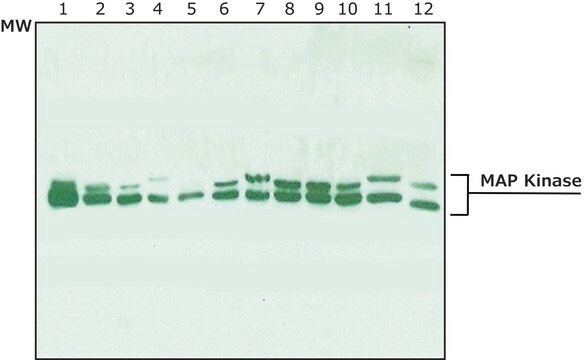17-650
ChIPAb+ Ubiquityl-Histone H2B - ChIP Validated Antibody and Primer Set
clone 56, from mouse, purified by using protein G
Sinónimos:
H2BUb, Histone H2B (ubiquityl), H2B histone family, member L, H2B.1 A, histone 1, H2bc, histone cluster 1, H2bc
About This Item
Productos recomendados
biological source
mouse
Quality Level
clone
56, monoclonal
purified by
using protein G
species reactivity
mouse, rat, vertebrates, human, plant
manufacturer/tradename
ChIPAb+
Upstate®
technique(s)
ChIP: suitable
immunofluorescence: suitable
immunoprecipitation (IP): suitable
western blot: suitable
isotype
IgG2aκ
NCBI accession no.
UniProt accession no.
shipped in
dry ice
General description
The ChIPAb+ Ubiquityl-Histone H2B, (clone 56) set includes the Ubiquityl-Histone H2B, (clone 56) antibody, a negative control antibody (purified Mouse IgG), and qPCR primers which amplify a 213 bp region within the coding region of the human GAPDH gene.
The ubiquityl-Histone H2B and negative control antibodies are supplied in a scalable "per ChIP" reaction size and can be used to functionally validate the precipitation of Ubiquityl-Histone H2B associated chromatin.
Specificity
Immunogen
Application
Sonicated chromatin prepared from HeLa S3 cells (1 X 106 cell equivalents per IP) was subjected to chromatin immunoprecipitation using 1 μg of either a normal mouse IgG or Anti-Ubiquityl-Histone H2B antibody and the Magna ChIP G Kit (Cat. # 17-611).
Successful immunoprecipitation of ubiquityl-Histone H2B associated DNA fragments was verified by qPCR using GAPDH promoter (negative) and GAPDH coding (positive) Primers (Please see figures). Data is presented as percent input of each IP sample relative to input chromatin for each amplicon and ChIP sample as indicated.
Please refer to the EZ-Magna G ChIP (Cat. # 17-409) or EZ-ChIP (Cat. # 17-371) protocol for experimental details.
Western Blot Analysis:
HeLa cell lysate was resolved by electrophoresis, transferred to PVDF and probed with anti-Ubiquityl-histone H2B at a dilution of 1:4000 (Please see figures).
Epigenetics & Nuclear Function
Chromatin Biology
Histones
Packaging
Quality
Sonicated chromatin prepared from HeLa S3 cells (1X 106 cell equivalents per IP) were subjected to chromatin immuno-precipitation using 1 µg of either a normal mouse IgG or Anti-ubiquityl-Histone H2B, clone 56 antibody and the Magna ChIP® G Kit (Cat. # 17-611). Successful immunoprecipitation of ubiquityl-Histone H2B-associated DNA fragments was verified by qPCR using Control Primers.
Please refer to the EZ-Magna ChIP G (Cat. # 17-409) or EZ-ChIP (Cat. # 17-371) protocol for experimental details.
Target description
Physical form
Normal Mouse IgG. One vial containing 25 μg purified mouse IgG in 25 μL storage buffer containing 0.1% sodium azide. Store at -20°C.
ChIP Primers GAPDH Coding Region. One vial containing 75 μL of 5 μM of each primer specific for the coding region of human GAPDH. Store at -20°C.
FOR: GGC TCC CAC CTT TCT CAT CC
REV: GGC CAT CCA CAG TCT TCT GG
Storage and Stability
Analysis Note
Includes negative control mouse IgG antibody and primers specific for human GAPDH coding region.
Legal Information
Disclaimer
Storage Class
10 - Combustible liquids
Certificados de análisis (COA)
Busque Certificados de análisis (COA) introduciendo el número de lote del producto. Los números de lote se encuentran en la etiqueta del producto después de las palabras «Lot» o «Batch»
¿Ya tiene este producto?
Encuentre la documentación para los productos que ha comprado recientemente en la Biblioteca de documentos.
Nuestro equipo de científicos tiene experiencia en todas las áreas de investigación: Ciencias de la vida, Ciencia de los materiales, Síntesis química, Cromatografía, Analítica y muchas otras.
Póngase en contacto con el Servicio técnico